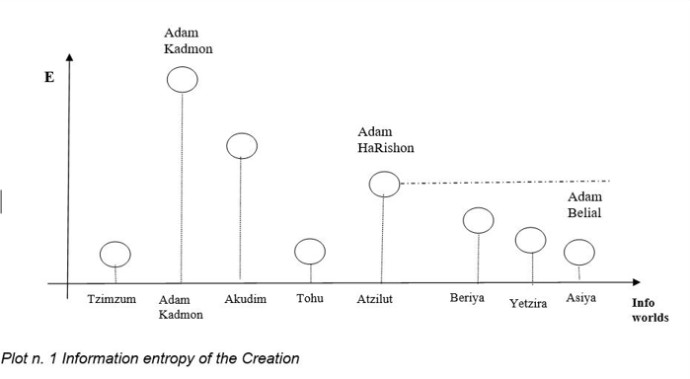Shabbat - Rehearsal of The Return

Part I: What is the rest of G-d?
The commandment of Shabbat is one of the central tenets of Judaism. Although many have attempted to comment on and explain it, some questions remain unanswered.
In this article, I will try to provide the answers to the following questions:
- What is the meaning of the Rest of G-d?
- Why is it prohibited to work on Shabbat?
- Why is the punishment for the violation of the commandment of Shabbat so strict - death and karet?
- How is Shabbat connected with the “Two Creations” of Adam?
- What is the general goal of the commandment of Shabbat?
My analysis will be governed by the following principles:
- G-d doesn’t do unnecessary work in order to achieve the goals of His Plan.
- The first creation of Adam took place in the information zone of the Sefira Malchut of the World of Atzilut. The creation of the worlds Beriya, Yetzira and Asiya (BYA) was caused by the Sin of Adam.
- Any event in the Creation must be considered from the point of view of “why it was necessary for the creation and existence of man.”
CREATION AND DESTRUCTION OF THE INFORMATION STRUCTURES
In order to analyze the notion of the Rest of G-D, let’s consider Plot 1, which describes the information entropy of the Creation.
The notion of information entropy was introduced by Claude Shannon in 1942 in his seminal work The Mathematical Theory of Communications.
According to Shannon, information entropy is defined as the logarithm of the number of possible information states of the system. For example, if just one state is possible, the information entropy equals zero. The meaning of the notion of information entropy is the degree of our uncertainty about the state of the system.
The notion of information entropy necessitates certain clarifications. In my view, existing information could be divided into two categories - general information and structural information.
General information is more of a quantitative nature; structural information is more of a qualitative nature.
An example of general information:
Imagine we have two spheres of the same mass: one made of iron and one of copper. By measuring the force of gravity or inertia, we cannot tell the difference between the two spheres.
If we have two Black Holes of the same mass, the first made of elephants and the other of crocodiles, we cannot tell the difference either.
Structural information gives us knowledge about the spatial and temporal interactions between different information entities.
According to the Kabbalah, there are two main forces in the Creation - Chesed and Gevura. Chesed is associated with unlimited expansion; Gevura with unlimited contraction. In our Universe, Chesed could be conditionally represented by the notion of kinetic energy and the force of repulsion, and Gevura by the force of attraction. In the extreme cases of the absolute Chesed or absolute Gevura, structural information doesn’t exist - only general one. The existence of any kind of structural information is the result of the subtle balance between Chesed and Gevura.
In our universe, absolute Chesed corresponds to the scenario of the Big Rip, while absolute Gevura corresponds to the scenario of the Big Crunch.
With this in mind, let’s consider Plot 1:
- The state before the Tzimzum is described in the Lurianic Kabbalah as the “infinite light of Ein Sof” - absolute Chesed. There, our degree of uncertainty is maximal.
- The state of Tzimzum is described as a contraction of Ein Sof, the creation of the “hollow spherical space” - absolute Gevura - and subsequent emanation of the ray of light into this hollow space - finite Chesed. Our degree of uncertainty is very low.
- The first information world created after Tzimzum was Adam Kadmon (Primordial Adam). We have a minimum amount of structural information; hence our degree of uncertainty is high. Here, we observe an increase of Chesed.
- The next world, Akudim, is described as a vessel which contains all the Sefirot. According to Arizal (The Tree of Life, Volume 2: The palace of Points, English ed.), the Sefira Malchut emerged first and after the rest other Sefirots. Here, there is a lot of structural information. The notions of information space (Sefira Malchut) and of Sefirot (information concepts) were introduced, which corresponds to the increase of Gevura and the reduction of uncertainty.
- The world of Nekudim (Tohu) - the world of points - is described as an information space scarcely populated by the Sefirot (singular information concepts) which don’t interact with one another. That corresponds to the significant increase of Gevura; the degree of uncertainty is almost zero.According to the Lurianic Kabbalah, the concepts of the world of Tohu were broken into less complex low dimensional concepts (the breakage of the vessels).
- In the world of Atzilut – information world densely populated by concepts, - the main structure is the fractal-shaped Tree of Sefirot. There is a huge number of possible states, and the information entropy is high. Chesed is increased.In the information zone of Sefira Malchut of the world of Atzilut, the creation of Adam HaRishon (The First Adam) took place. If Adam HaRishon hadn’t sinned, that would have been the end of Creation. In the Etz Hayim (The Tree of Life, Volume 2, The Palace of Points, English ed.), Arizal describes the breakage of the vessels in the world of Tohu and the subsequent emanation of the world of Atzilut as two Shabbats.
- As a result of the Sin of Adam HaRishon, the information dimensions of evil (the other side, or the anti-commandments) were actualized, which caused Almighty to begin the Six Days of Creation of the worlds BYA.The worlds BYA are the “Seals of the world of Atzilut” (Etz Hayim). Their structure is identical to the structure of the world of Atzilut. Here, we observe the hierarchy of concepts with diminishing dimensionality and complexity, and an increase of Gevura.
- As the result of the Sin, Adam HaRishon was expelled from the Garden of Eden (died relatively to the Garden of Eden), and Adam Belial was created in the world of Asiya.
There, the Creation was stopped.
From the information above, it is clear that the Creation has two stops: the first “would have happened” on the world of Atzilut – the Supernal Shabbat. The actual stop happened on the world of Asiya – Shabbat.
From that, we conclude that the Rest of G-d is the cessation of extending the Information Hierarchy.
At the same time, G-d applies continuous, never-ending work to support the existing hierarchy.
This is described well by the story of the conversation between Rabbi Akiva and the Roman Governor Turnus Rufus (the Wicked) (Torah commentary by Rabbi Bachya ben Asher). The latter asked Rabbi Akiva sarcastically: “What is so special about this day compared to other days?”
Rabbi Akiva replied: “How is one man superior to other men?” (that he arrogates to himself special powers and status).
Turnus Rufus answered: “The King of Kings evidently wanted to honor me!”
Rabbi Akiva replied that the King of Kings also wanted to honor the Shabbat.
Turnus Rufus replied: “If so, why does He Himself perform work on the Shabbat?” Rabbi Akiva: “What work does G-d do on the Shabbat?” Turnus Rufus: “Just as He performs work on the weekdays, He performs the same activities on the Shabbat!” [implying that we do not observe a change in nature on the Shabbat]
Rabbi Akiva: “I know you are familiar with Jewish law and our Torah. You therefore are aware that when two people living in adjoining houses and sharing the same courtyard are allowed to carry in the courtyard if they first have established a partnership called Eruv. This means that each of them abandons his exclusive claim to his property for the benefit of the second party. If, however, a single individual lives in a house surrounded by a very large courtyard without a neighbor sharing it, he may carry inside it without the need of an Eruv. The reason is that he does not thereby infringe on the property rights of anyone else. G-d knows heaven and earth; He has no partners to whom He has to cede part of His exclusive rights. Hence, He is free to let the sun rise, make the wind blow, the rain fall, etc. without infringing on the Shabbat legislation.”
I conclude this article with the thesis that the General Goal of the Creation is the return of Adam Belial to the state of Adam HaRishon before the Sin.
How this goal is connected to the commandment of Shabbat will be discussed in subsequent articles.
To purchase Eduard Shyfrin’s book ‘From Infinity to Man: The Fundamental Ideas of Kabbalah Within the Framework of Information Theory and Quantum Physics’ please click here. To purchase Eduard Shyfrin’s book ‘Travels with Sushi in the Land of the Mind’ please click here.
Jerusalem Post Store
`; document.getElementById("linkPremium").innerHTML = cont; var divWithLink = document.getElementById("premium-link"); if (divWithLink !== null && divWithLink !== 'undefined') { divWithLink.style.border = "solid 1px #cb0f3e"; divWithLink.style.textAlign = "center"; divWithLink.style.marginBottom = "15px"; divWithLink.style.marginTop = "15px"; divWithLink.style.width = "100%"; divWithLink.style.backgroundColor = "#122952"; divWithLink.style.color = "#ffffff"; divWithLink.style.lineHeight = "1.5"; } } (function (v, i) { });

